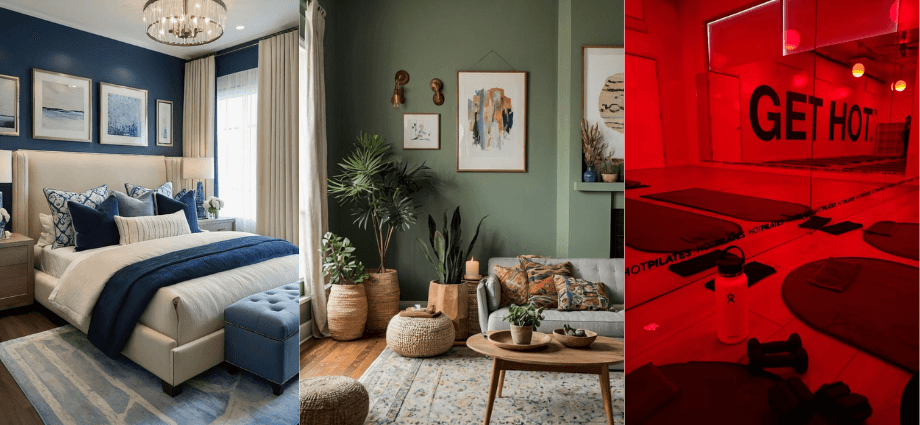Colors have a powerful impact on the atmosphere of a room. They can make a space feel larger, more inviting, calmer, or even more energetic. By understanding how colors affect mood and selecting the right hues, you can completely transform any room. This article explores how to use color to influence the feel of a room, providing tips for choosing colors that align with the function and mood you want to create.
Understanding Color Psychology
Color psychology is the study of how colors influence our emotions and behaviors. Different colors can evoke specific feelings, making it essential to choose the right ones for the atmosphere you wish to create. Understanding the basics of color psychology helps you make informed choices that suit the purpose of each room.
What is Color Psychology?
Color psychology is based on the idea that colors affect our emotions. For example, blue is known for its calming effects, while red is associated with energy and excitement. By understanding these associations, you can choose colors that help foster the right mood in any space.
Colors have a deep psychological impact, and using the right ones can enhance your overall experience of a room.
Warm vs. Cool Colors
Colors are often categorized into warm and cool tones. Each category has its own effect on the atmosphere of a room.
- Warm Colors: These include red, orange, yellow, and browns. Warm colors are energizing and make a space feel intimate and cozy.
- Cool Colors: Blue, green, and purple are considered cool colors. These tones are calming and can make a room feel more open and expansive.
When choosing colors, think about the mood you want to create and how each color contributes to that atmosphere.
Choosing Colors for Different Rooms
Every room in your home serves a different purpose, and selecting the right colors can enhance each room’s functionality. The color choices you make should align with the activities that typically happen in those spaces.
For living rooms and common areas, choose colors that encourage relaxation and socializing. Soft blues are calming, perfect for creating a peaceful atmosphere. Neutrals like beige, gray, or taupe act as versatile backdrops, allowing you to add colorful accents. Warm earth tones, such as terracotta and mustard, create a cozy vibe without overwhelming the space.
In bedrooms, the goal is to foster a restful environment. Soft greens, like sage, bring a sense of tranquility, while pale blues create a calming effect. Lavender and soft purples also evoke serenity, making them great choices for bedrooms or any space dedicated to relaxation.
Kitchens and dining areas benefit from colors that energize and stimulate appetite. Yellow is a cheerful and energizing color, ideal for kitchens. Red can increase appetite and interaction, making it perfect for dining areas. Whites and off-whites keep the space feeling fresh and clean while complementing colorful accessories.
For bathrooms and smaller spaces, light colors help create a sense of openness. Soft grays and whites reflect light, making the space feel airy and fresh. Pastels like pale blue or peach add a gentle touch of color without feeling overwhelming, making the room feel larger and brighter.
By carefully selecting colors based on the function of each room, you can create spaces that feel inviting, calming, or energizing, depending on your needs.
How to Use Color to Create a Specific Mood

The colors you choose can directly influence the mood of a room. Whether you want a calming retreat or a lively, energetic environment, color can play a huge role.
Creating Calm and Relaxation
If you want a room to feel peaceful and relaxing, you’ll need to choose calming colors that help promote relaxation.
Soft blues are calming and ideal for spaces where you want to unwind and de-stress. Greens, especially softer shades like sage, bring the serenity of nature indoors, helping create a peaceful environment. Lavender is another soothing color, making it perfect for bedrooms or meditation spaces.
These colors help create a soothing environment, making them perfect for areas where you need to relax.
Adding Energy and Excitement
For spaces meant to energize and inspire activity, use colors that create a sense of vibrancy and enthusiasm.
Red is an energetic color that boosts excitement and motivation, making it ideal for home gyms or dining rooms where you want to feel energized. Yellow is a bright, happy color that stimulates conversation and appetite, making it a great choice for kitchens or dining areas. Orange, like red and yellow, is energizing and lively, great for social spaces where you want people to interact and feel engaged.
These colors can give any room an exciting and dynamic feel, encouraging activity and conversation.
Tips for Choosing the Right Color Scheme
Choosing the right color for a room involves considering factors like size, lighting, and the overall style you want to achieve. Here are some tips to guide your choices.
Consider the Room’s Size and Lighting
The size of the room and the amount of natural light it receives can greatly affect how colors look and feel.
- Small Rooms: Use lighter colors, like pale gray or white, to make the space feel larger and more open.
- Large Rooms: Darker shades, such as navy or charcoal, can make large rooms feel more intimate and cozy.
- Lighting: Natural light makes colors appear brighter, while artificial light can change how a color looks. Be mindful of the room’s lighting when choosing shades.
Experiment with Color Combinations
Once you have your main colors, experiment with how they interact to create balance.
- Complementary Colors: Pair colors that are opposite on the color wheel, like blue and orange, to create contrast and visual interest.
- Analogous Colors: Use colors next to each other on the color wheel, such as green and yellow, for a harmonious and cohesive look.
- Monochromatic Colors: Different shades of the same color, like dark blue to light blue, create a calm, unified effect.
Experimenting with different combinations can help you create the ideal atmosphere.
Conclusion
Color is one of the most powerful tools for transforming the feel of a room. By choosing the right shades, you can change the mood of any space, whether you want it to feel peaceful, energetic, or cozy. Understand the psychological effects of colors, and experiment with combinations to create a space that reflects your personal style and meets the needs of each room. The right color choices can truly make a space come to life.




